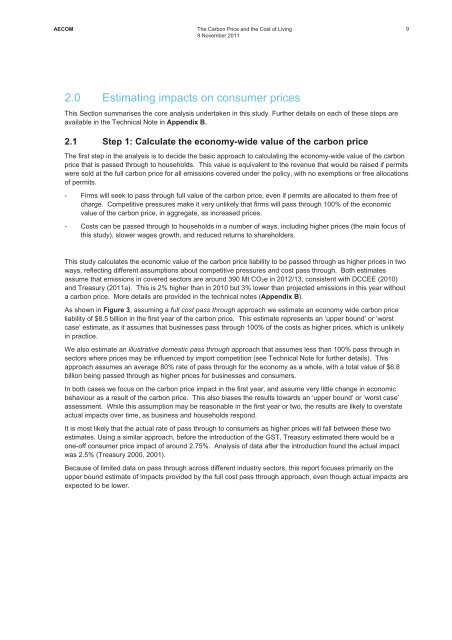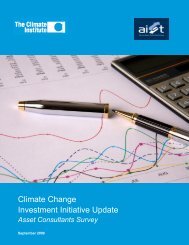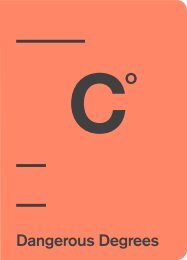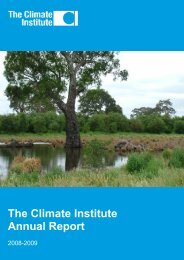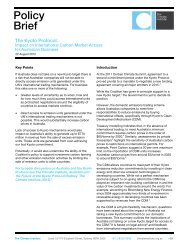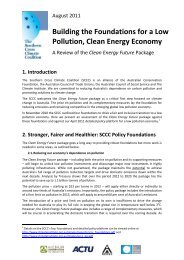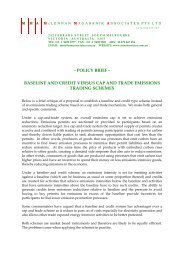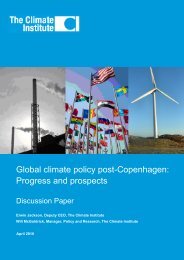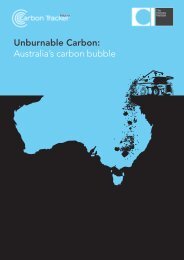The Carbon Price and the Cost of Living - The Climate Institute
The Carbon Price and the Cost of Living - The Climate Institute
The Carbon Price and the Cost of Living - The Climate Institute
You also want an ePaper? Increase the reach of your titles
YUMPU automatically turns print PDFs into web optimized ePapers that Google loves.
AECOM<br />
<strong>The</strong> <strong>Carbon</strong> <strong>Price</strong> <strong>and</strong> <strong>the</strong> <strong>Cost</strong> <strong>of</strong> <strong>Living</strong><br />
9 November 2011<br />
9<br />
2.0 Estimating impacts on consumer prices<br />
This Section summarises <strong>the</strong> core analysis undertaken in this study. Fur<strong>the</strong>r details on each <strong>of</strong> <strong>the</strong>se steps are<br />
available in <strong>the</strong> Technical Note in Appendix B.<br />
2.1 Step 1: Calculate <strong>the</strong> economy-wide value <strong>of</strong> <strong>the</strong> carbon price<br />
<strong>The</strong> first step in <strong>the</strong> analysis is to decide <strong>the</strong> basic approach to calculating <strong>the</strong> economy-wide value <strong>of</strong> <strong>the</strong> carbon<br />
price that is passed through to households. This value is equivalent to <strong>the</strong> revenue that would be raised if permits<br />
were sold at <strong>the</strong> full carbon price for all emissions covered under <strong>the</strong> policy, with no exemptions or free allocations<br />
<strong>of</strong> permits.<br />
- Firms will seek to pass through full value <strong>of</strong> <strong>the</strong> carbon price, even if permits are allocated to <strong>the</strong>m free <strong>of</strong><br />
charge. Competitive pressures make it very unlikely that firms will pass through 100% <strong>of</strong> <strong>the</strong> economic<br />
value <strong>of</strong> <strong>the</strong> carbon price, in aggregate, as increased prices.<br />
- <strong>Cost</strong>s can be passed through to households in a number <strong>of</strong> ways, including higher prices (<strong>the</strong> main focus <strong>of</strong><br />
this study), slower wages growth, <strong>and</strong> reduced returns to shareholders.<br />
This study calculates <strong>the</strong> economic value <strong>of</strong> <strong>the</strong> carbon price liability to be passed through as higher prices in two<br />
ways, reflecting different assumptions about competitive pressures <strong>and</strong> cost pass through. Both estimates<br />
assume that emissions in covered sectors are around 390 Mt CO 2 e in 2012/13, consistent with DCCEE (2010)<br />
<strong>and</strong> Treasury (2011a). This is 2% higher than in 2010 but 3% lower than projected emissions in this year without<br />
a carbon price. More details are provided in <strong>the</strong> technical notes (Appendix B).<br />
As shown in Figure 3, assuming a full cost pass through approach we estimate an economy wide carbon price<br />
liability <strong>of</strong> $8.5 billion in <strong>the</strong> first year <strong>of</strong> <strong>the</strong> carbon price. This estimate represents an ‘upper bound’ or ‘worst<br />
case’ estimate, as it assumes that businesses pass through 100% <strong>of</strong> <strong>the</strong> costs as higher prices, which is unlikely<br />
in practice.<br />
We also estimate an illustrative domestic pass through approach that assumes less than 100% pass through in<br />
sectors where prices may be influenced by import competition (see Technical Note for fur<strong>the</strong>r details). This<br />
approach assumes an average 80% rate <strong>of</strong> pass through for <strong>the</strong> economy as a whole, with a total value <strong>of</strong> $6.8<br />
billion being passed through as higher prices for businesses <strong>and</strong> consumers.<br />
In both cases we focus on <strong>the</strong> carbon price impact in <strong>the</strong> first year, <strong>and</strong> assume very little change in economic<br />
behaviour as a result <strong>of</strong> <strong>the</strong> carbon price. This also biases <strong>the</strong> results towards an ‘upper bound’ or ‘worst case’<br />
assessment. While this assumption may be reasonable in <strong>the</strong> first year or two, <strong>the</strong> results are likely to overstate<br />
actual impacts over time, as business <strong>and</strong> households respond.<br />
It is most likely that <strong>the</strong> actual rate <strong>of</strong> pass through to consumers as higher prices will fall between <strong>the</strong>se two<br />
estimates. Using a similar approach, before <strong>the</strong> introduction <strong>of</strong> <strong>the</strong> GST, Treasury estimated <strong>the</strong>re would be a<br />
one-<strong>of</strong>f consumer price impact <strong>of</strong> around 2.75%. Analysis <strong>of</strong> data after <strong>the</strong> introduction found <strong>the</strong> actual impact<br />
was 2.5% (Treasury 2000, 2001).<br />
Because <strong>of</strong> limited data on pass through across different industry sectors, this report focuses primarily on <strong>the</strong><br />
upper bound estimate <strong>of</strong> impacts provided by <strong>the</strong> full cost pass through approach, even though actual impacts are<br />
expected to be lower.


